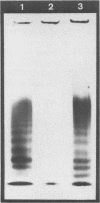Abstract
Platelet-type von Willebrand disease (vWD) and pseudo-vWD are two recently described intrinsic platelet defects characterized by enhanced ristocetin-induced agglutination in platelet-rich plasma. A similar finding is also typical of type IIB vWD, where it has been related to a von Willebrand factor (vWF) rather than a platelet abnormality. Platelet aggregation induced by unmodified human vWF in the absence of other stimuli has been reported in pseudo-vWD. In this study we demonstrate that vWF induces aggregation in platelet-type but not type IIB vWD. Aggregation is observed when normal plasma cryoprecipitate or purified vWF are added to platelet-rich plasma. Cryoprecipitate also aggregates washed platelets, although at higher concentrations than required for platelet-rich plasma. Purified vWF, however, induces significant aggregation of washed platelets only when plasma is added. EDTA inhibits vWF-induced aggregation. Its effect can be overcome by calcium but much less effectively by magnesium ions. Unstimulated platelets in platelet-rich plasma from patients with platelet-type but not type IIB vWD bind 125I-vWF in a specific and saturable manner. All different sized multimers of vWF become associated with platelets. Both aggregation and binding exhibit a similar vWF concentration dependence, suggesting that a correlation exists between these two events. Removal of ADP by appropriate consuming systems is without effect upon such binding or upon vWF-induced aggregation. Thrombin-induced 125I-vWF binding to washed platelets is normal in platelet-type as well as type IIB vWD. These results demonstrate that a specific binding site for unmodified human vWF is exposed on unstimulated platelets in platelet-type vWD. The relatively high vWF concentrations required for aggregation and binding may explain the lack of significant in vivo aggregation and thrombocytopenia in these patients. Moreover, these studies provide additional evidence that platelet-type and type IIB vWD are different diseases with distinct pathogeneses.
Full text
PDF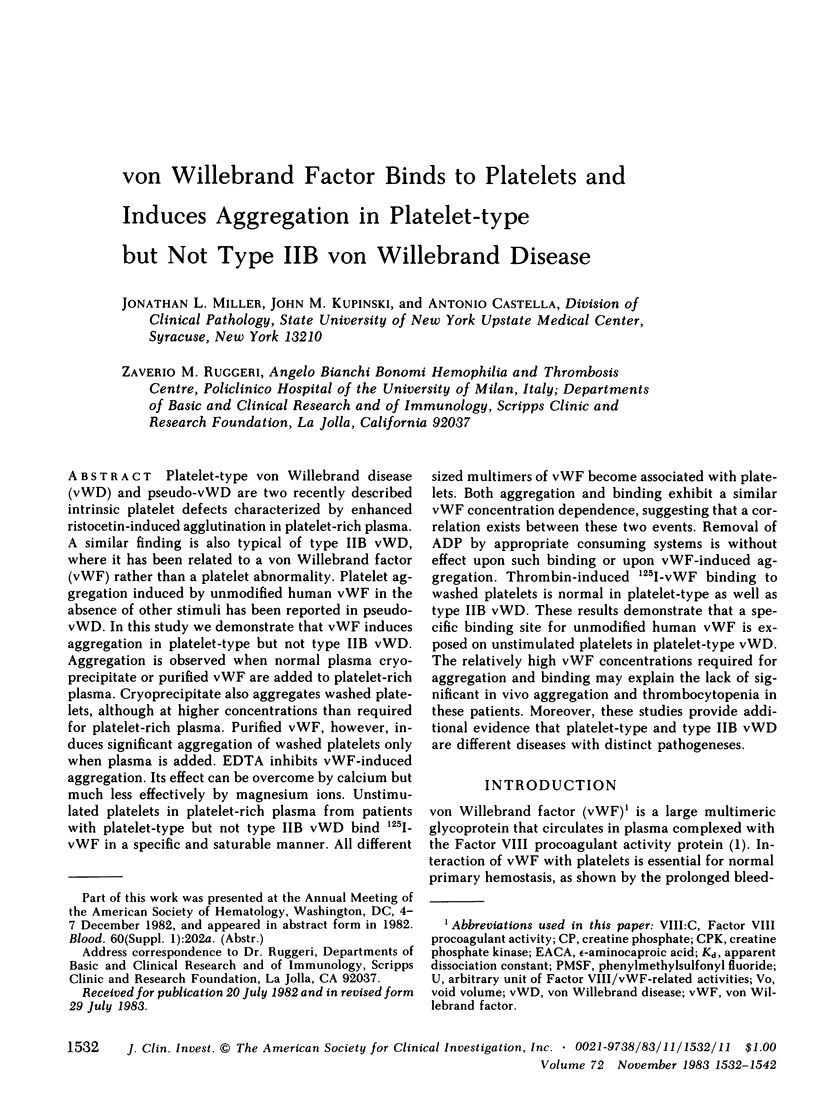
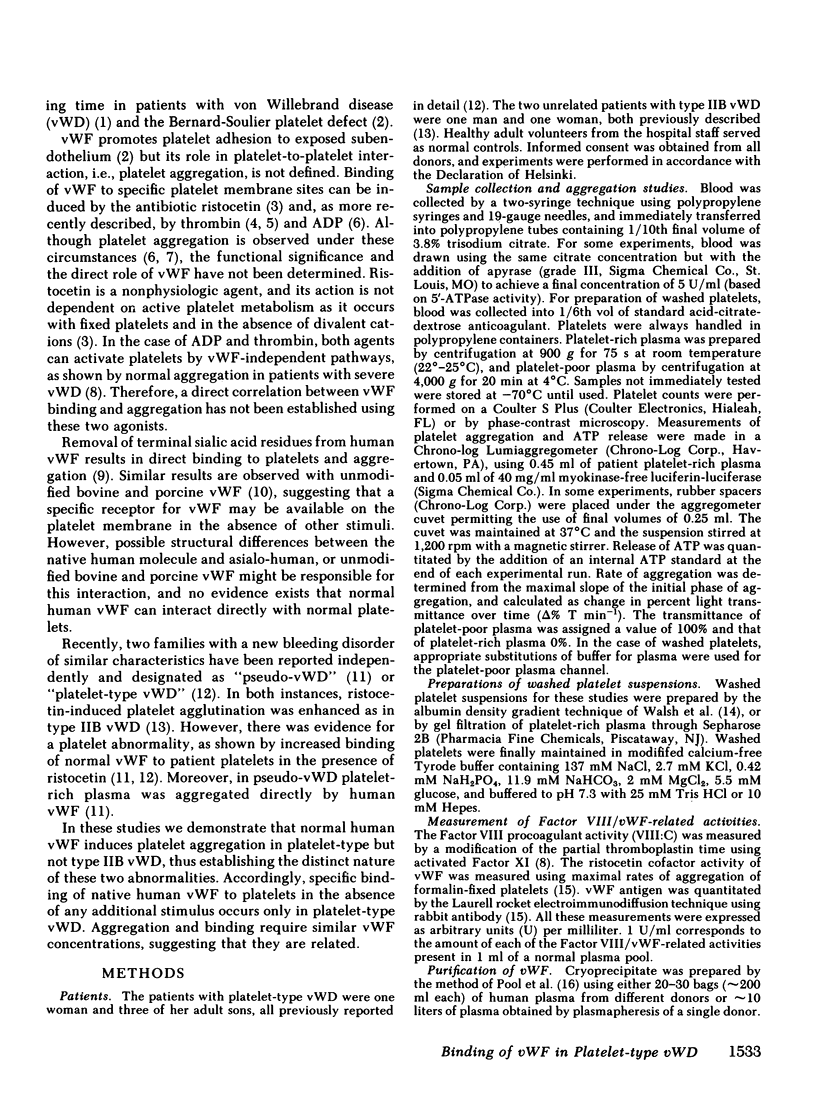
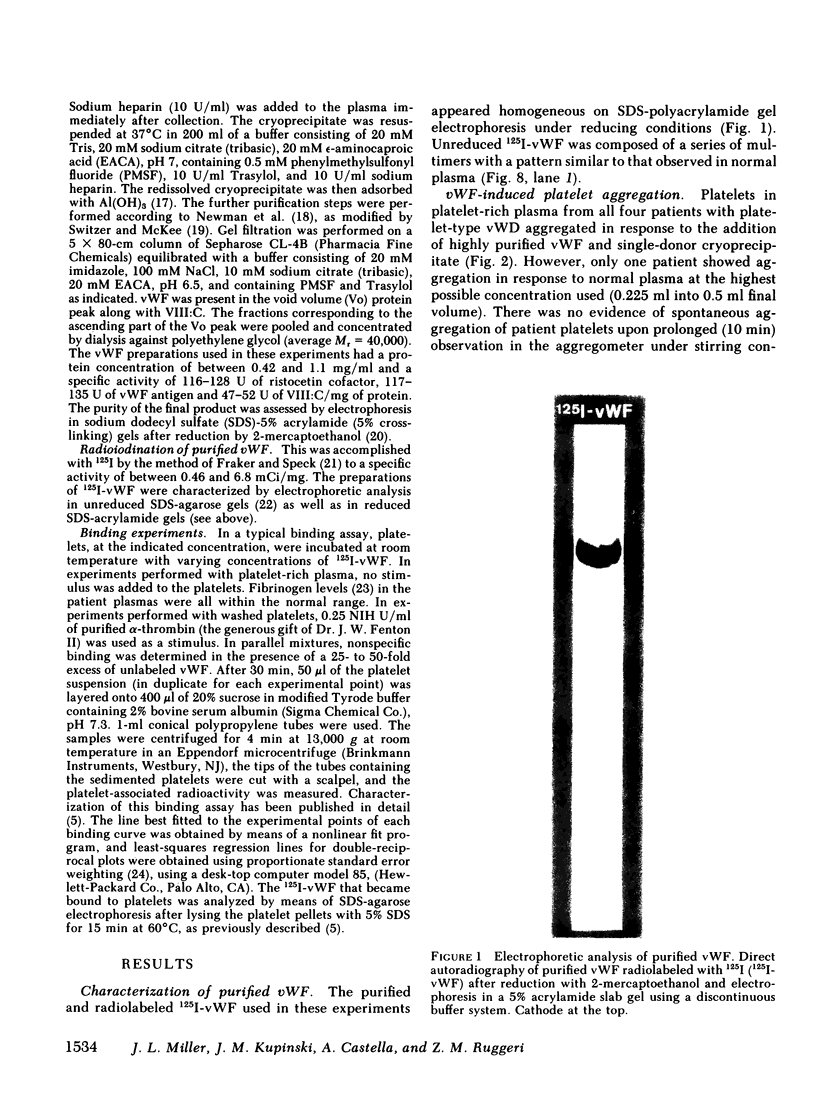
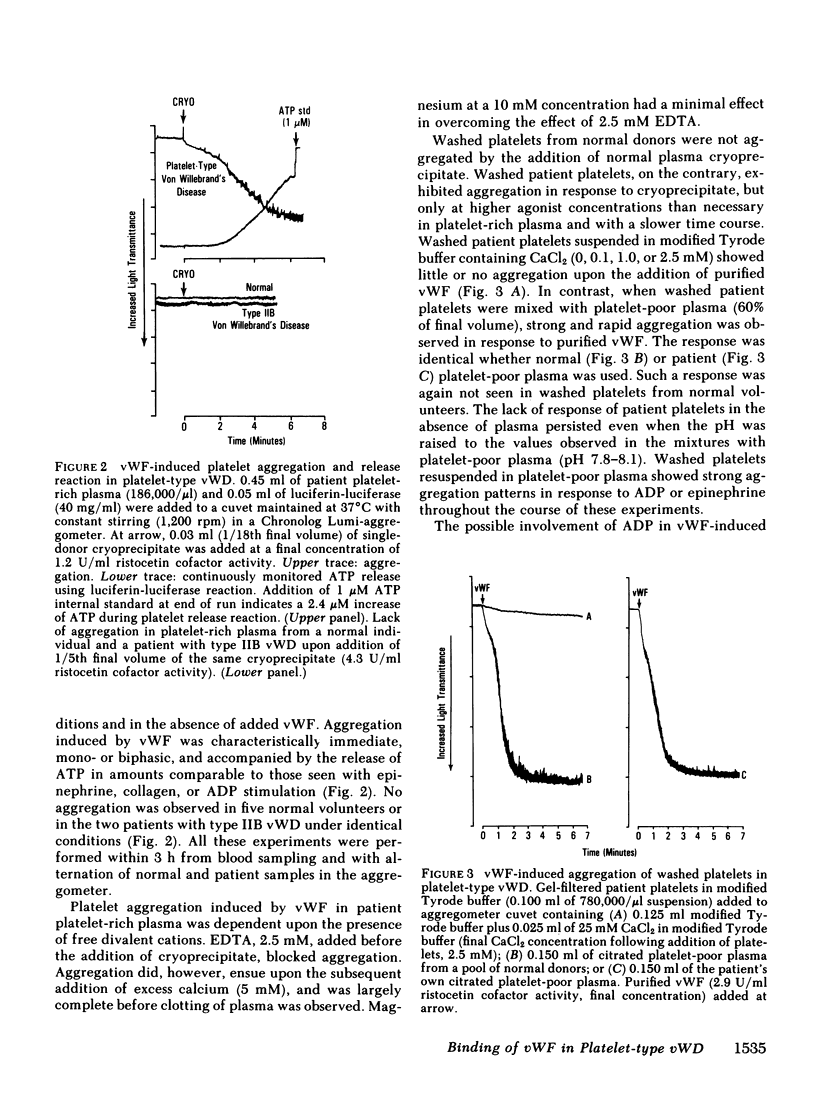
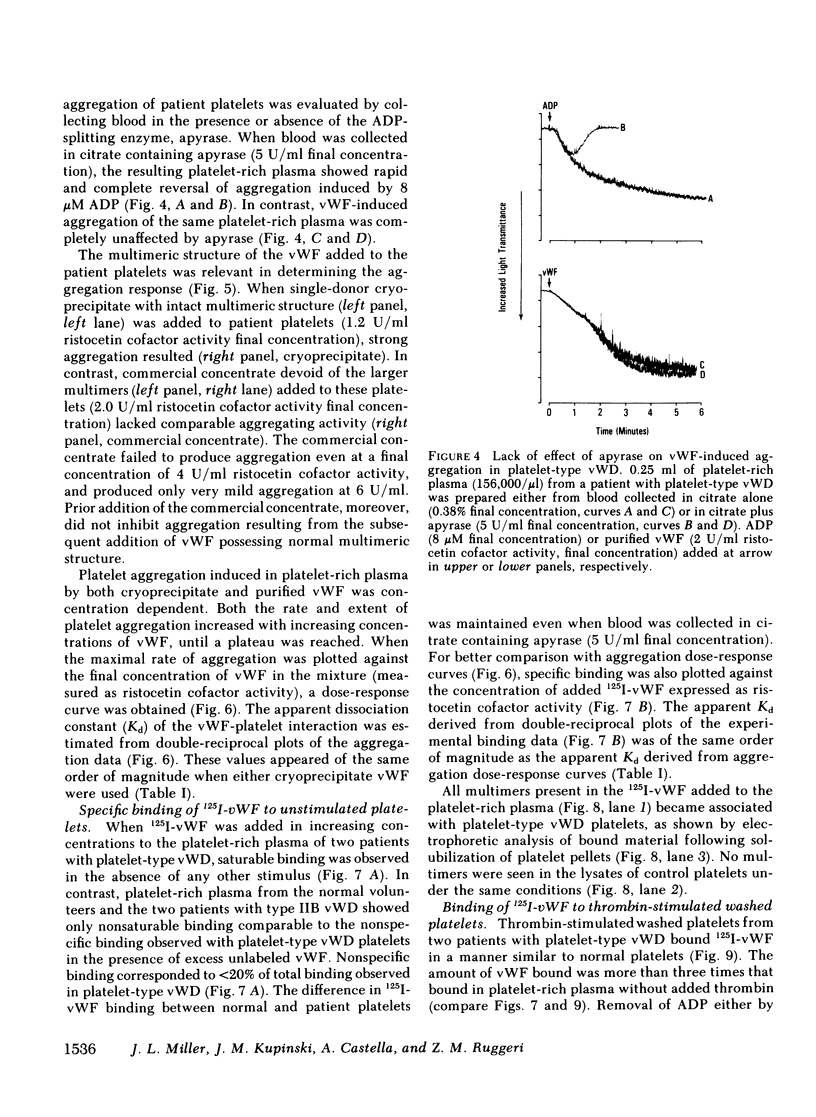
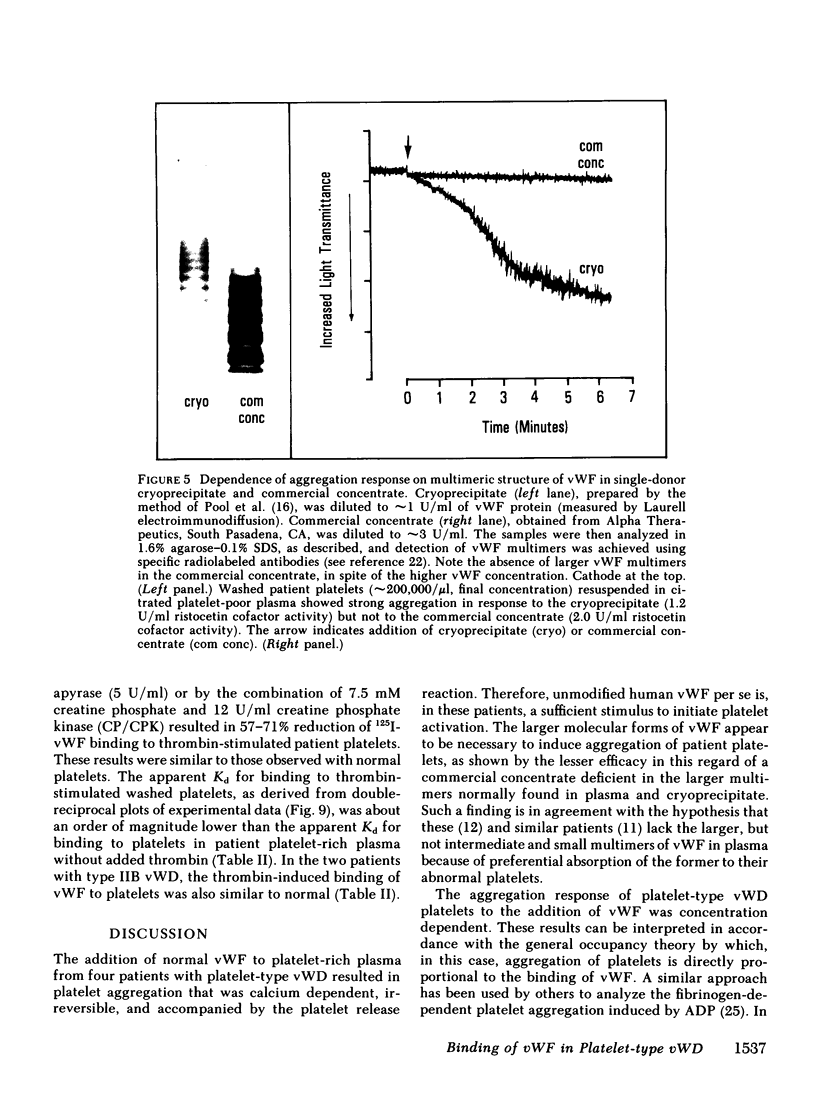
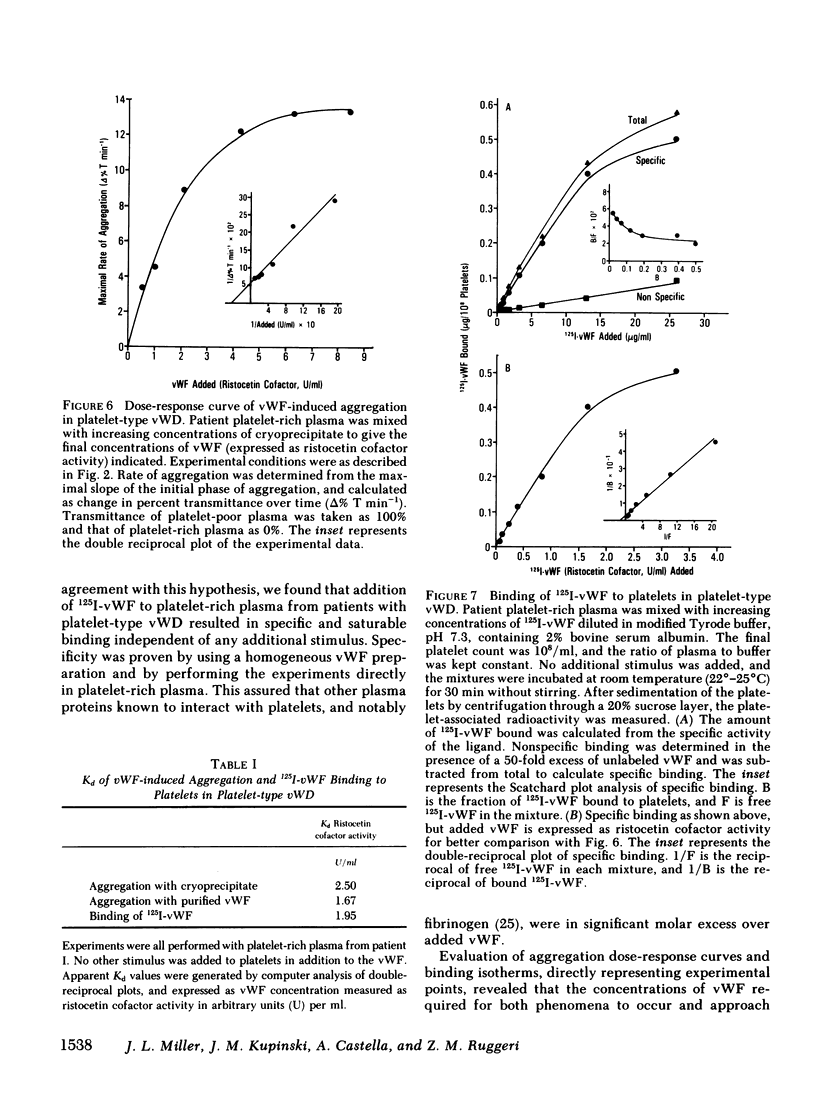
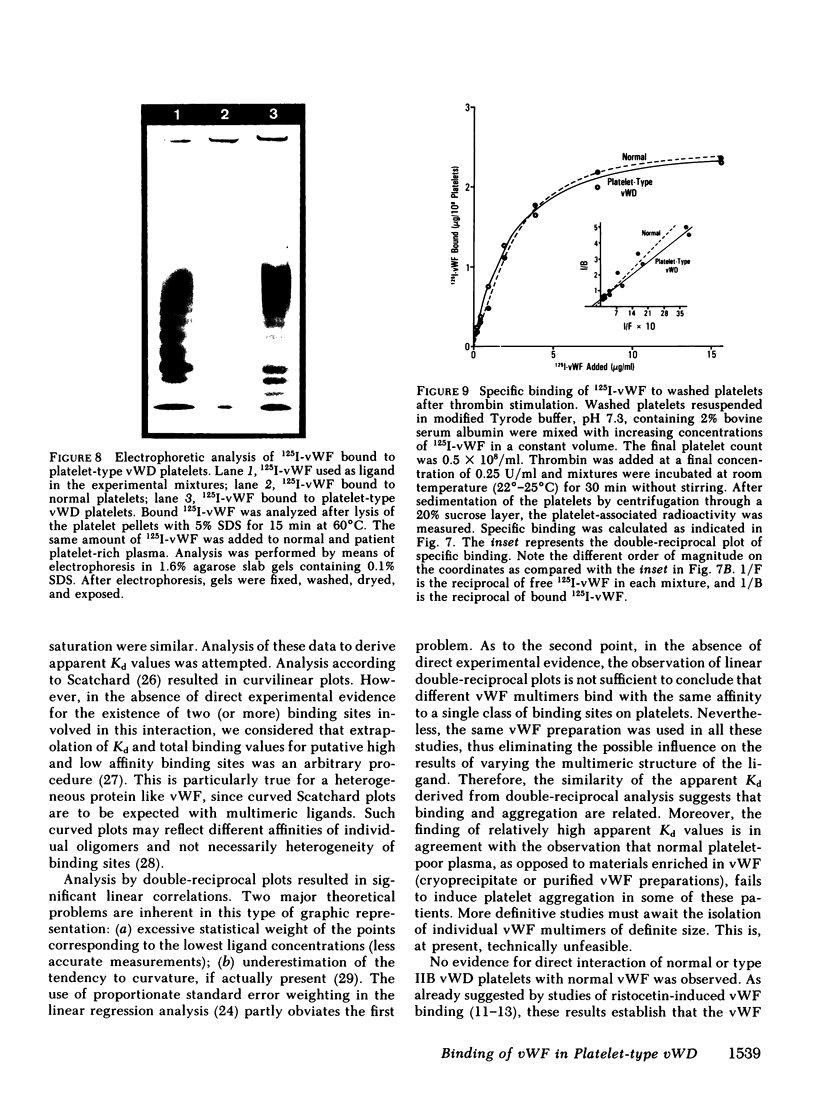
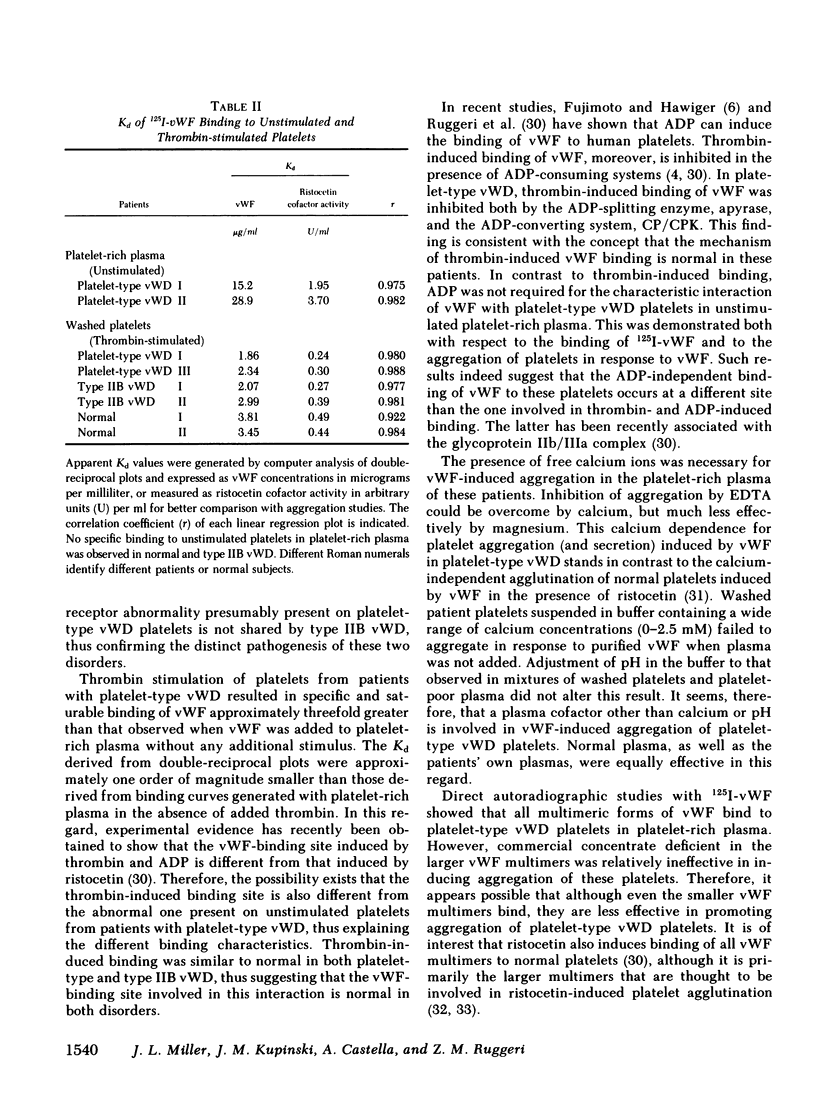
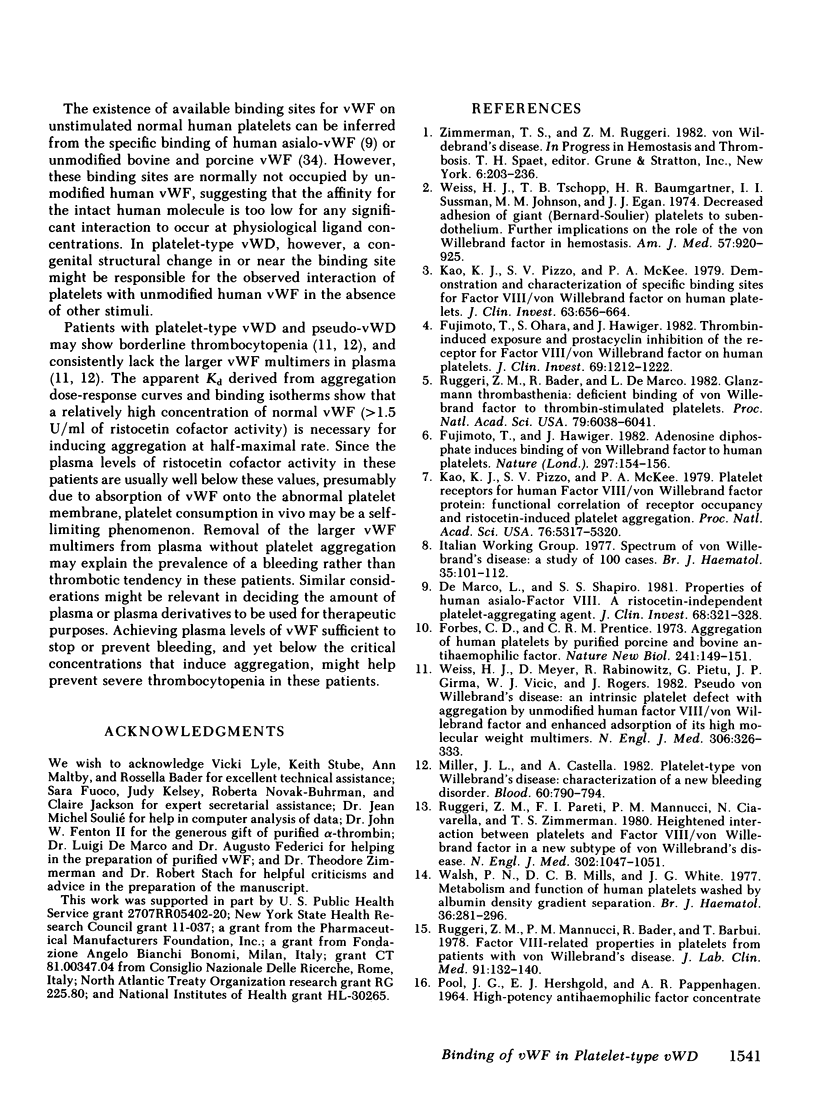
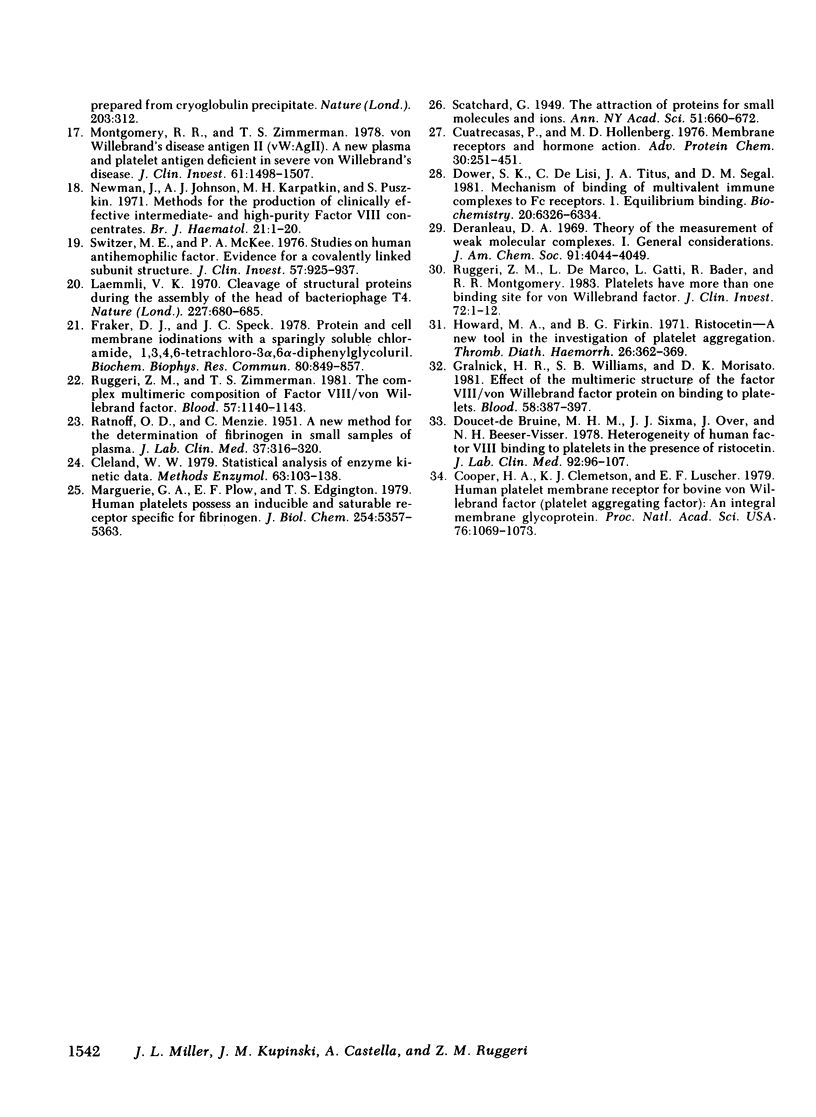
Images in this article
Selected References
These references are in PubMed. This may not be the complete list of references from this article.
- Cleland W. W. Statistical analysis of enzyme kinetic data. Methods Enzymol. 1979;63:103–138. doi: 10.1016/0076-6879(79)63008-2. [DOI] [PubMed] [Google Scholar]
- Cooper H. A., Clemetson K. J., Lüscher E. F. Human platelet membrane receptor for bovine von Willebrand factor (platelet aggregating factor): an integral membrane glycoprotein. Proc Natl Acad Sci U S A. 1979 Mar;76(3):1069–1073. doi: 10.1073/pnas.76.3.1069. [DOI] [PMC free article] [PubMed] [Google Scholar]
- Cuatrecasas P., Hollenberg M. D. Membrane receptors and hormone action. Adv Protein Chem. 1976;30:251–451. doi: 10.1016/s0065-3233(08)60481-7. [DOI] [PubMed] [Google Scholar]
- De Marco L., Shapiro S. S. Properties of human asialo-factor VIII. A ristocetin-independent platelet-aggregating agent. J Clin Invest. 1981 Aug;68(2):321–328. doi: 10.1172/JCI110259. [DOI] [PMC free article] [PubMed] [Google Scholar]
- Doucet-de Bruïne M. H., Sixma J. J., Over J., Beeser-Visser N. H. Heterogeneity of human factor VIII. II. Characterization of forms of factor VIII binding to platelets in the presence of ristocetin. J Lab Clin Med. 1978 Jul;92(1):96–107. [PubMed] [Google Scholar]
- Dower S. K., DeLisi C., Titus J. A., Segal D. M. Mechanism of binding of multivalent immune complexes to Fc receptors. 1. Equilibrium binding. Biochemistry. 1981 Oct 27;20(22):6326–6334. doi: 10.1021/bi00525a007. [DOI] [PubMed] [Google Scholar]
- Forbes C. D., Prentice C. R. Aggregation of human platelets by purified porcine and bovine antihaemophilic factor. Nat New Biol. 1973 Jan 31;241(109):149–150. doi: 10.1038/newbio241149a0. [DOI] [PubMed] [Google Scholar]
- Fraker P. J., Speck J. C., Jr Protein and cell membrane iodinations with a sparingly soluble chloroamide, 1,3,4,6-tetrachloro-3a,6a-diphrenylglycoluril. Biochem Biophys Res Commun. 1978 Feb 28;80(4):849–857. doi: 10.1016/0006-291x(78)91322-0. [DOI] [PubMed] [Google Scholar]
- Fujimoto T., Hawiger J. Adenosine diphosphate induces binding of von Willebrand factor to human platelets. Nature. 1982 May 13;297(5862):154–156. doi: 10.1038/297154a0. [DOI] [PubMed] [Google Scholar]
- Fujimoto T., Ohara S., Hawiger J. Thrombin-induced exposure and prostacyclin inhibition of the receptor for factor VIII/von Willebrand factor on human platelets. J Clin Invest. 1982 Jun;69(6):1212–1222. doi: 10.1172/JCI110560. [DOI] [PMC free article] [PubMed] [Google Scholar]
- Gralnick H. R., Williams S. B., Morisato D. K. Effect of multimeric structure of the factor VIII/von Willebrand factor protein on binding to platelets. Blood. 1981 Aug;58(2):387–397. [PubMed] [Google Scholar]
- Howard M. A., Firkin B. G. Ristocetin--a new tool in the investigation of platelet aggregation. Thromb Diath Haemorrh. 1971 Oct 31;26(2):362–369. [PubMed] [Google Scholar]
- Kao K. J., Pizzo S. V., McKee P. A. Demonstration and characterization of specific binding sites for factor VIII/von Willebrand factor on human platelets. J Clin Invest. 1979 Apr;63(4):656–664. doi: 10.1172/JCI109348. [DOI] [PMC free article] [PubMed] [Google Scholar]
- Kao K. J., Pizzo S. V., McKee P. A. Platelet receptors for human Factor VIII/von Willebrand protein: functional correlation of receptor occupancy and ristocetin-induced platelet aggregation. Proc Natl Acad Sci U S A. 1979 Oct;76(10):5317–5320. doi: 10.1073/pnas.76.10.5317. [DOI] [PMC free article] [PubMed] [Google Scholar]
- Laemmli U. K. Cleavage of structural proteins during the assembly of the head of bacteriophage T4. Nature. 1970 Aug 15;227(5259):680–685. doi: 10.1038/227680a0. [DOI] [PubMed] [Google Scholar]
- Marguerie G. A., Plow E. F., Edgington T. S. Human platelets possess an inducible and saturable receptor specific for fibrinogen. J Biol Chem. 1979 Jun 25;254(12):5357–5363. [PubMed] [Google Scholar]
- Miller J. L., Castella A. Platelet-type von Willebrand's disease: characterization of a new bleeding disorder. Blood. 1982 Sep;60(3):790–794. [PubMed] [Google Scholar]
- Montgomery R. R., Zimmerman T. S. von Willebrand's disease antigen II. A new plasma and platelet antigen deficient in severe von Willebrand's disease. J Clin Invest. 1978 Jun;61(6):1498–1507. doi: 10.1172/JCI109070. [DOI] [PMC free article] [PubMed] [Google Scholar]
- Newman J., Johnson A. J., Karpatkin M. H., Puszkin S. Methods for the production of clinically effective intermediate- and high-purity factor-VIII concentrates. Br J Haematol. 1971 Jul;21(1):1–20. doi: 10.1111/j.1365-2141.1971.tb03413.x. [DOI] [PubMed] [Google Scholar]
- RATNOFF O. D., MENZIE C. A new method for the determination of fibrinogen in small samples of plasma. J Lab Clin Med. 1951 Feb;37(2):316–320. [PubMed] [Google Scholar]
- Ruggeri Z. M., Bader R., de Marco L. Glanzmann thrombasthenia: deficient binding of von Willebrand factor to thrombin-stimulated platelets. Proc Natl Acad Sci U S A. 1982 Oct;79(19):6038–6041. doi: 10.1073/pnas.79.19.6038. [DOI] [PMC free article] [PubMed] [Google Scholar]
- Ruggeri Z. M., De Marco L., Gatti L., Bader R., Montgomery R. R. Platelets have more than one binding site for von Willebrand factor. J Clin Invest. 1983 Jul;72(1):1–12. doi: 10.1172/JCI110946. [DOI] [PMC free article] [PubMed] [Google Scholar]
- Ruggeri Z. M., Mannucci P. M., Bader R., Barbui T. Factor VIII-related properties in platelets from patients with von Willebrand's disease. J Lab Clin Med. 1978 Jan;91(1):132–140. [PubMed] [Google Scholar]
- Ruggeri Z. M., Pareti F. I., Mannucci P. M., Ciavarella N., Zimmerman T. S. Heightened interaction between platelets and factor VIII/von Willebrand factor in a new subtype of von Willebrand's disease. N Engl J Med. 1980 May 8;302(19):1047–1051. doi: 10.1056/NEJM198005083021902. [DOI] [PubMed] [Google Scholar]
- Ruggeri Z. M., Zimmerman T. S. The complex multimeric composition of factor VIII/von Willebrand factor. Blood. 1981 Jun;57(6):1140–1143. [PubMed] [Google Scholar]
- Switzer M. E., McKee P. A. Studies on human antihemophilic factor. Evidence for a covalently linked subunit structure. J Clin Invest. 1976 Apr;57(4):925–937. doi: 10.1172/JCI108369. [DOI] [PMC free article] [PubMed] [Google Scholar]
- Walsh P. N., Mills D. C., White J. G. Metabolism and function of human platelets washed by albumin density gradient separation. Br J Haematol. 1977 Jun;36(2):287–296. doi: 10.1111/j.1365-2141.1977.tb00649.x. [DOI] [PubMed] [Google Scholar]
- Weiss H. J., Meyer D., Rabinowitz R., Pietu G., Girma J. P., Vicic W. J., Rogers J. Pseudo-von Willebrand's disease. An intrinsic platelet defect with aggregation by unmodified human factor VIII/von Willebrand factor and enhanced adsorption of its high-molecular-weight multimers. N Engl J Med. 1982 Feb 11;306(6):326–333. doi: 10.1056/NEJM198202113060603. [DOI] [PubMed] [Google Scholar]
- Weiss H. J., Tschopp T. B., Baumgartner H. R., Sussman I. I., Johnson M. M., Egan J. J. Decreased adhesion of giant (Bernard-Soulier) platelets to subendothelium. Further implications on the role of the von Willebrand factor in hemostasis. Am J Med. 1974 Dec;57(6):920–925. doi: 10.1016/0002-9343(74)90170-3. [DOI] [PubMed] [Google Scholar]





